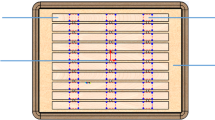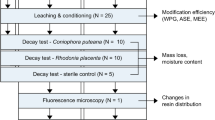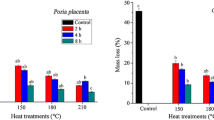Summary
Incense cedar heartwood infected by the pocket rot fungus Polyporus amarus was subjected to microtensile testing and miscroscopical examination to determine effects of this fungus upon wood substance adjacent to advanced decay pockets. Although springwood of the annual ring nearest the decay pocket in some samples had a slightly lower tensile strength than springwood from the same ring but a distance from the pocket, the difference was not statistically significant. Microscopical examination revealed the presence of small, sparse bore holes and hyphae in approximately the same number inside and outside the advanced decay pockets, and in discolored regions of incipient decay. A few bore holes and hyphae were found in specimens from what was macroscopically considered to be sound wood. Polarized illumination revealed no evidence of diffusion of cellulolytic enzymes from the hyphae in regions other than within advanced decay pockets, but the small numbers of hyphae and bore holes observed in decay pockets indicated that considerable enzyme diffusion might be necessary for decay to procede. The data suggest that possible alteration of physical, mechanical, and chemical properties in wood substance surrounding decay pockets need not be a significant factor for consideration in utilization of pecky incense cedar.
Zusammenfassung
Kernholz von Zeder (Libocedrus decurrens), das von Polyporus amarus befallen worden war, wurde Mikro-Zugfestigkeitsprüfungen und einer mikroskopischen Durchmusterung unterworfen. Es sollten die Auswirkungen dieses Pilzbefalles auf jene Teile der Holzsubstanz geprüft werden, die unmittelbar an die Befallsstellen angrenzen. Das Frühholz eines Jahrringes, das einer Befallsstelle am nächsten lag, zeigte zwar bei einigen Proben eine geringfügig niedrigere Zugfestigkeit als das Frühholz desselben Jahrringes, das aber von der Befallsstelle weiter entfernt lag. Die Unterschiede waren jedoch statistisch nicht signifikant. Die mikroskopische Durchmusterung deckte das Vorhandensein von kleinen, etwas zerstreut liegenden Bohrlöchern und Hyphen auf, in etwa gleichgroßer Anzahl innerhalb und außerhalb der Stellen fortgeschrittenen Befalls und in den verfärbten Bereichen des beginnenden Befalls. Einige wenige Bohrlöcher und Hyphen wurden ferner in Proben festgetsellt, die bei makroskopischer Betrachtung gesund erschienen. Im polarisierten Licht ließ sich keine Diffusion von aus Hyphen stammenden celluloitischen Enzymen außerhalb der Befallsbereiche beobachten. Die wenigen Hyphen und Bohrlöcher, die in den Befallsstellen beobachtet werden konnten, gaben aber einen Hinweis darauf, daß bei der Ausbreitung eine beträchtliche Enzymdiffusion stattfinden muß. Die ermittelten Werte weisen darauf hin, daß die möglicherweise eintretende Änderung der physikalischen, mechanischen und chemischen Eigenschaften des Holzes in unmittelbarer Umgebung der Befallsstellen als wichtige Faktoren bei der Verarbeitung dieses Holzes beachtet werden müssen.
Similar content being viewed by others
References
Boyce, J. S.: The Dry-rot of Incense Cedar. U. S. Dept. Agr. Bull. (1920) No. 871.58 p.
Boyce, J. S.: Decay in Pacific Northwest Conifers. Yale Univ. Osborn Bot. Lab. (1930) Bull. 1. 51 p.
Harkness, H. W.: A Foe to the Lumberman. Pacific Rural Press Vol 17 (1879) No. 4, p. 49.
Hubert, E. E.: An Outline of Forest Pathology. New York 1931: John Wiley and Sons, Inc.
Ifju, G.: Tensile Strength Behavior as a Function of Cellulose in Wood. For. Prod. J. Vol. 14 (1964) p. 366/372.
Kennedy, R. W., and G. Ifju: Applications of Microtensile Testing to Thin Wood Sections. Tappi Vol. 45 (1962) p. 725/733.
Kimmey, J. W.: Cultural. Factors for Forest-tree Species in Northwestern California. U. S. Dept. Agr., California Forest Range Exp. Sta., Forest Survey Release No. 7, 1950, 30 p.
Meinecke, E. P.: Forest Tree Diseases Common in California and Nevada. U. S. Dept. Agr., Forest Service. 1914, 67 p.
Sass, J. E.: Botanical Microtechnique. 3rd ed. The Iowa State College Press, Ames. 1958, 228 p.
Schniewind, A. P.: Transverse Anisotropy of Wood: A Function of Gross Anatomic Structure. For. Prod. J. Vol. 9 (1959) p. 350/359.
Schrenk, H. von: A Disease of Taxodium distichum Known as Peckiness, also a Similar Disease of Libocedrus decurrens known as Pin-rot. Missouri Bot. Garden Annual Rep. 11. 1900, p. 23/77.
Steel, R. G. D., and J. H. Torrie: Principles and Procedures of Statistics. New York 1960: McGraw-Hill Book Co., Inc.
Wagener, W. W., and R. V. Bega: Heart Rot of Incense Cedar. U. S. Dept. Agr., Forest Service, Forest Pest Leafl. 30, 1958, 7 p.
Wilcox, W. W.: Preparation of Decayed Wood for Microscopical Examination. U. S. Forest Service Res. Note FPL-056, 1964a, 22 p.
Wilcox, W. W.: Progressive Microscopical Changes in Wood Caused by a White-rot and a Brown-rot Fungus. Ph. D. Thesis. Univ. of Wisconsin. 1964b, 127 p. (to be published as U. S. Forest Service Res. Paper FPL-70).
Wilson, J. W., and G. Ifju: Wood Characteristics VI: Measuring Density and Strength Properties of Minute Wood Specimens. Pulp and Paper Res. Inst. Canada, Tech. Rep. 423, 1965, 15 p.
Author information
Authors and Affiliations
Rights and permissions
About this article
Cite this article
Wilcox, W.W., Garcia, B.J. Changes in wood properties at the boundary of polyporus amarus decay pockets. Wood Sci.Technol. 2, 115–127 (1968). https://doi.org/10.1007/BF00394960
Received:
Issue Date:
DOI: https://doi.org/10.1007/BF00394960




